
Pretty much everything that is (hopefully) useful, practical, and relevant which I can tell you about this wonderful Thai ingredient has been said in my post on how to use Nam Prik Pao in modern Thai cooking. And since I will not go into its historical background (as the purpose at hand is to create the kind of Thai chilli jam that is used in contemporary Thai cooking), the only thing left to talk about is how to make this versatile condiment at home.
The following two methods of making Nam Prik Pao are what I have been using. Both have their pros and cons.
The first method requires pan-toasting dried red chilies, slicing thinly and pan-frying the garlic and shallots, and pan-frying the dried shrimp.1
Pros:
- This method yields a smokier, “nuttier” jam the taste of which resembles that of commercial Nam Prik Pao except it’s fresher and more flavorful.
- The “jamming” stage takes less time due to the dehydration and caramelization of the garlic and shallots caused by pan-frying. It takes no more than 20 minutes over medium heat for the mixture to become loose jam which thickens up further upon cooling.
- This method yields the kind of Nam Prik Pao that is the most versatile. It can be used in Tom Yam, stir-fries, etc. It’s terrific as a bread spread or a dip for fish skin “chips” or fried pork rinds whereas the result of the other method is, in my opinion, more limited in its usefulness (details on that below).
Cons:
- The mandatory hand-slicing of the garlic and shallots is tedious and time-consuming. These ingredients need to be cut into uniformly thin slices to facilitate the process of pan-frying; this cannot be done in a food processor. To ensure even cooking and minimize mess, you may even want to follow what Kasma Loha-unchit has suggested which is to leave the sliced garlic and shallots out to dry a little before pan-frying them. Once dehydrated, they fry up more quickly and brown up more evenly without much oil splattering. While that’s helpful, it also presents an extra step.
- From my experience, making (or telling people to make) Nam Prik Pao this way seems to bring all sorts of critics out of the woodwork. Even my paternal grandmother insisted Nam Prik Pao wasn’t made this way. You just have to be prepared to explain to them that your main objective is not to recreate the historical Nam Prik Pao — whatever it might look like and however it was made — but to make the kind of condiment that is known in the here and now as Nam Prik Pao and used in contemporary Thai cuisine. To achieve that kind of Nam Prik Pao, you need to make it this way.
The second method (favored by my paternal grandmother) requires the roasting of the key ingredients. My grandmother would put whole garlic cloves and shallots on the skewers and roast them over low coals or an open flame of the stove until they’re soft and slightly charred. The shrimp paste would be wrapped in a banana leaf packet and roasted in the same manner. The dried chilies would go into a skillet and get dry-toasted until they crisp up and become just slightly blistered on the outside.2 Then everything would be pounded together in a mortar and fried in oil.
Preparing the ingredients by roasting instead of frying them is the way my grandmother had been taught to do. And if she was here today, she’d most likely give you a lengthy treatise on how it is precisely due to the roasting of ingredients that this condiment has come to be referred to as Nam Prik Pao, literally roasted nam prik (chilli paste or chilli relish).
Though this makes a lot of sense, I can’t prove or disprove it. Actually, I’m not sure I’m interested in either.
Care needs to taken not to burn them to prevent Nam Prik Pao that is dead on arrival.
Pros:
- You don’t need to slice anything manually; you don’t need to pan-fry anything either. This shaves off more than half of the preparation time and significantly reduces the number of greasy things to wash.
- Roasting the ingredients is pretty easy and results in less mess than pan-frying.
- You end up with Nam Prik Pao that’s terrific to serve mixed with rice and as a chili relish. It also works great in stir-fries and Tom Yam. For these applications, Nam Prik Pao derived through this method serves you well (see its limitations in the Cons section below).
Cons:
- Nam Prik Pao made this way, in my opinion, lacks the depth of flavor that is achieved through the caramelization of the ingredients through pan-frying in oil.
- Nam Prik Pao made this way doesn’t make such a great bread spread. If I hadn’t grown up spreading my bread with commercial Nam Prik Pao, I might have loved this. But since that’s not the case, Nam Prik Pao made with the second method presents an unfamiliar taste as a spread.
- Without the caramelization and dehydration of the main ingredients (achieved through pan-frying), things get sloshy in the mortar and when grandma asked you to pound the paste in a mortar, you’d get cranky. After about half an hour, you’d get bothcranky and spattered with chili paste.
- For the same reason stated in the previous point, the mixture, being so wet, takes much longer to reduce to jam-like consistency. Also, the end result never gets to be the familiar mahogany color; no matter how long you fry it, it never gets darker than dark terracotta.
- Choose whichever method works best for you. Or try both and decide which you like better. But if you know that you really, really like the flavor of commercial Nam Prik Pao, I’d suggest you go with the first method. Both methods employ the same ingredients; they’re just prepared differently.Please note that the measurements, except for the liquids, are in metrics. This is because measuring these ingredients in cups and spoons has yielded inconsistent results in my many experiments. Besides, I’m assuming that those who care enough to make Nam Prik Pao from scratch most likely own a kitchen scale.
- 34g deseeded dried red chilies (Thai long peppers or arbol chilies) – Make sure you weigh the chilies after they have been stemmed and deseeded. The amount of seeds you add back into the paste when you grind it determines the level of heat. More seeds, more heat. I like my Nam Prik Pao medium-hot, so I add 50% of the seeds back into the paste.
- 64g peeled garlic cloves
- 84g peeled shallots
- 20g Thai shrimp paste
- 190g palm sugar, chopped into small pieces
- 24g dried shrimp
- 4 tablespoons tamarind paste (see how to prepare tamarind pulp)
- 4 tablespoons fish sauce
- 1 cup water
- ½ c. vegetable oil
- Cut the garlic cloves and shallots lengthwise into uniformly thin slices. Separate the two. Spread them out on two cookie sheets to dry a little.
- Heat up about ½ to ¾ cup of vegetable oil (this amount of oil is in addition to the ½ cup of oil that will be used later to fry the chili paste) in an 8- to 12-inch fry pan over medium heat. Fry the garlic and shallot slices, separately, until light brown and crisp; set aside.
- Do the same with the dried shrimp; set aside.
- In a dry skillet over medium-low heat, toast the dried chilies until they have changed their texture from somewhat rubbery to somewhat brittle. Be careful not to burn them.
- In a granite mortar or food processor, pound or grind all the garlic, shallots, dried shrimp, and dried chilies into a fine paste; set aside.
- Put the paste and the remaining ingredients, including the ½ cup vegetable oil, in a shallow and wide pan set over medium heat. Cook everything, stirring occasionally, for about 15 minutes until everything has dissolved and you get a fried paste that is thinner than commercial Nam Prik Pao.
- Remove the pan from heat and let the mixture cool completely.
- Check for consistency. If the paste is still too thin, reduce it some more over medium heat. When you have achieved the desired consistency, store your Nam Prik Pao in a clean glass jar. No need to drain off the oil.







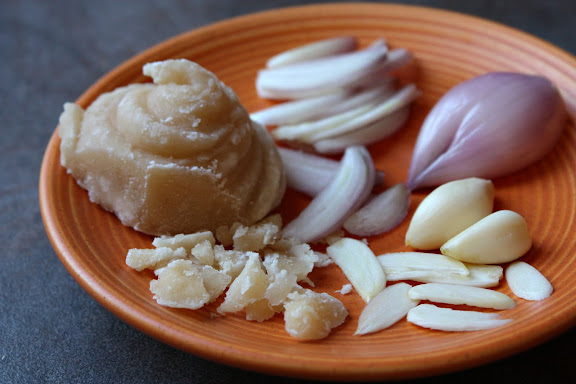

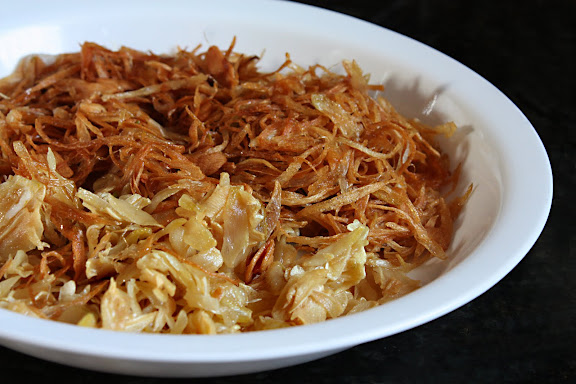
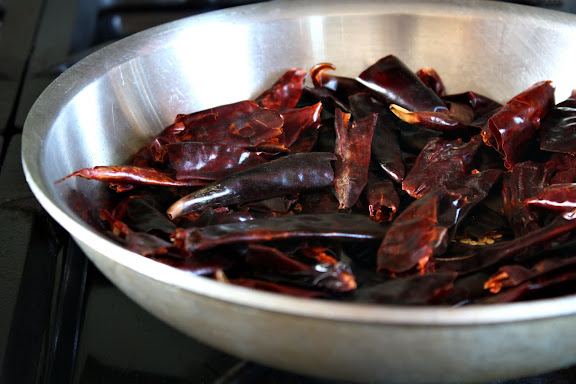
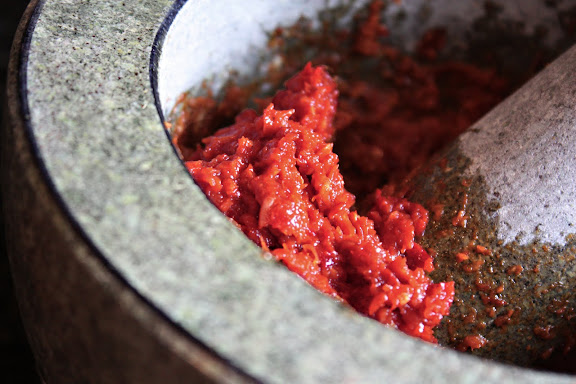
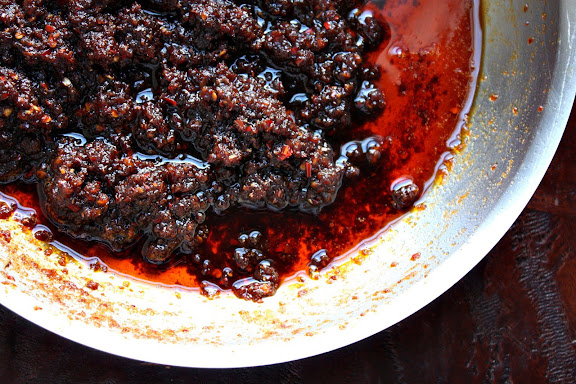
45 Responses to Nam Prik Pao Recipe (น้ำพริกเผา) – Thai Chilli Jam